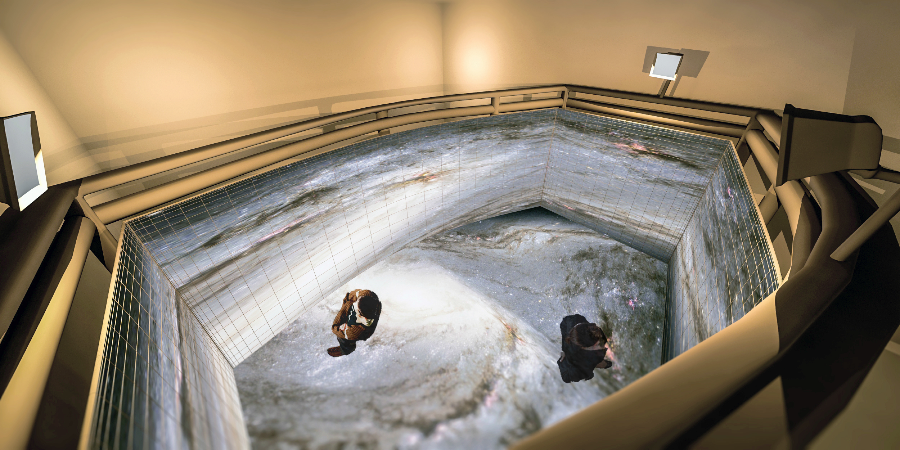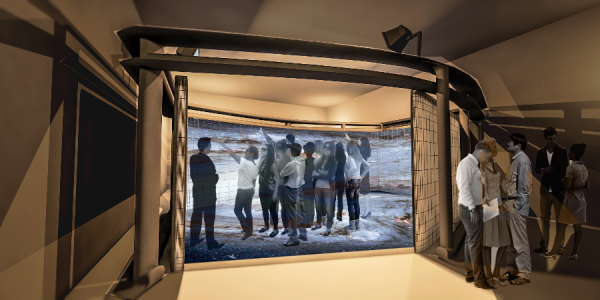The Department of Architecture’s Dr. Winifred Newman (Associate Professor and Director of Advanced Studies) is leading a team of seven FIU faculty members designing and developing a new Virtual Reality (VR) system on campus. The new instrument is called the I-CAVE (Integrated – Computer Augmented Virtual Environment). The FIU School of Architecture and School of Computing and Information Sciences recently finalized the location of the facility and made plans to move towards its completion.
The I-CAVE is a large room with wall-to-wall and floor LED flex-screens and a surround-sound system that creates an immersive virtual reality experience. The room, a 15-feet by 11-feet cube, tracks how a person moves within the space with a four-camera shutter-synchronized tracking system. This system eliminates the need for the equipment that is usually needed for movement tracking on other platforms, such as gloves or headgear.
 “The I-CAVE enhances instructional technology in a number of ways,” said Dr. Newman. “First, using a total immersion environment as an instructional space offers new and exciting possibilities for all departments to incorporate animations, large-scale imagery, and virtual realities into their curriculum. Second, students will be able to propose their own projects for the I-CAVE, thus learning to plan, design and work through issues related to data visualization, basic computing skills, and information fusion. Third, CAVEs are dynamic instruments that require constant development and adjustment for research.”
“The I-CAVE enhances instructional technology in a number of ways,” said Dr. Newman. “First, using a total immersion environment as an instructional space offers new and exciting possibilities for all departments to incorporate animations, large-scale imagery, and virtual realities into their curriculum. Second, students will be able to propose their own projects for the I-CAVE, thus learning to plan, design and work through issues related to data visualization, basic computing skills, and information fusion. Third, CAVEs are dynamic instruments that require constant development and adjustment for research.”
The new facility will be available for use by FIU students and instructors across all disciplines. Dr. Newman said, “Student involvement with the I-CAVE will occur . . . as instructional space for courses, faculty-sponsored and student-generated research and creative projects, and for the development of skills necessary to run and maintain an active, immersive virtual reality instrument.” One of the team’s focuses is the ease and timeliness with which the I-CAVE can be operated. According to Dr. Newman, “this facility will offer state-of-the art imagery and user-friendly interaction so that students and faculty can develop projects quickly and with minimal start time.”
Currently, there are CAVE facilities located on most major research universities in the United States and abroad. This includes the Computer Graphics Group at Brown University, the Visualization Research Lab at the University of New Hampshire, the Electronic Visualization Lab at the University of Chicago, and the Calit2 at the California Institute of Telecommunications and Information Technology.
The FIU I-CAVE will be only the second Virtual Reality environment built in the Florida university system, after the facility at the University of Central Florida.
The I-CAVE will be located on the FIU Modesto A. Maidique Campus, at the Engineering & Computer Science building. It will be designed, constructed, developed and maintained by FIU’s School of Architecture, School of Computing and Information Science, Department of Electrical Engineering, Instructional & Research Computing Center-High Performance Computing, and University Technology Services.
Dr. Newman and the FIU I-CAVE team were granted $502,489.00 for the project through the university’s Tech Fee. The team will be working with several industry partners in South Florida, California, and China to develop a way to field test equipment, look at alternatives, and develop practices as they finalize the design.
Below is the list of FIU faculty members involved in the development of the new I-CAVE.
Dr. Winifred Newman
College of Architecture + The Arts | School of Architecture
Dr. Scott Graham
School of Computing and Information Sciences
Mr. Eric S. Johnson
School of Computing and Information Sciences
Mr. Mike Kirgen
Division of Information Technology, Instructional & Research Computing Center-High Performance Computing
Dr. Shu-Ching Chen
School of Computing and Information Sciences
Dr. Nezih Pala
Electrical and Computer Engineering
Mr. Steve Luis
School of Computing and Information Sciences
This article was written with the help of the FIU I-CAVE team.
The images in this article are provided by the FIU I-CAVE team.
Follow FIU Architecture on Facebook, Twitter, and Instagram.



